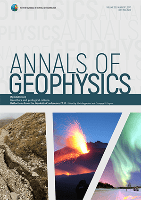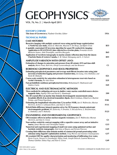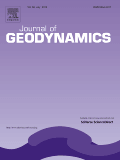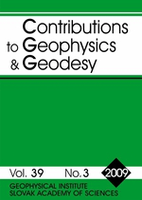
Geofizicheskiy Zhurnal-Geophysical Journal
Scope & Guideline
Bridging Theory and Practice in Geophysical Science
Introduction
Aims and Scopes
- Geophysical Exploration and Evaluation:
Focuses on innovative methodologies for exploring and evaluating geological formations, particularly in relation to hydrocarbon and mineral resources. This includes petrophysical evaluations, seismic data interpretation, and geophysical modeling. - Geological and Geophysical Research:
Covers comprehensive studies on the geological structure and processes of various regions, including detailed analyses of tectonic movements, sedimentary basins, and crustal dynamics. - Environmental Geophysics:
Investigates the impact of geophysical processes on environmental conditions, including studies on groundwater resources, geothermal energy potential, and the effects of climate change on geological formations. - Seismicity and Natural Hazards:
Analyzes the seismic activity within different regions, offering insights into earthquake prediction, risk assessment, and the geophysical factors contributing to seismic events. - Geoelectrical and Magnetic Studies:
Utilizes geoelectric and magnetic methods to explore subsurface structures, assess mineral deposits, and monitor environmental changes, contributing to both academic research and practical applications.
Trending and Emerging
- Geothermal Energy Research:
An increasing number of papers are focusing on the assessment and utilization of geothermal energy resources, highlighting the importance of sustainable energy solutions in the context of climate change and energy transition. - Climate Change Impacts on Geophysical Processes:
Recent publications are increasingly addressing the effects of climate change on geological and geophysical processes, including studies on temperature variations, hydrological changes, and their implications for natural hazards. - Integrated Geophysical Modeling:
There is a growing trend towards the integration of various geophysical methods for comprehensive subsurface modeling, which enhances the understanding of complex geological structures and processes. - Hydrogen Exploration and Geochemistry:
Emerging research is focusing on the exploration of hydrogen as a potential energy source, particularly in relation to its geological formation and extraction methods, reflecting a global interest in alternative energy resources. - Remote Sensing and UAV Applications:
The use of unmanned aerial vehicles (UAVs) and remote sensing technologies in geophysical research is on the rise, facilitating innovative approaches to data collection and analysis in challenging environments.
Declining or Waning
- Traditional Geological Mapping Techniques:
There has been a noticeable decline in publications focusing solely on traditional geological mapping methods, as newer technologies and methodologies, such as remote sensing and geophysical modeling, gain prominence. - Historical Geology Studies:
Research related to historical geology, including detailed studies on ancient geological formations and paleoclimate reconstructions, has become less frequent, possibly due to a shift towards more contemporary and applied geophysical research. - Static Hydrocarbon Studies:
The focus on static assessments of hydrocarbon potential in specific regions is waning, with more emphasis now placed on dynamic modeling and real-time monitoring of hydrocarbon reservoirs.
Similar Journals

ANNALS OF GEOPHYSICS
Unlocking the Secrets of Our Planet's DynamicsANNALS OF GEOPHYSICS is a prestigious open access journal dedicated to the advancement and dissemination of research in the field of geophysics. Published by the IST NAZIONALE DI GEOFISICA E VULCANOLOGIA in Italy, this journal has embraced open access since its inception in 1948, promoting wide accessibility to cutting-edge research. With an impressive Scopus ranking, placing it in the 52nd percentile within Earth and Planetary Sciences for the category of Geophysics, the journal serves as a vital platform for scholars, researchers, and practitioners seeking to explore the intricate phenomena of our planet. Covering a diverse range of topics in the geophysical community, the ANNALS OF GEOPHYSICS invites contributions that push the boundaries of our knowledge and understanding of geophysical processes, aiding in the development of innovative solutions to urgent environmental challenges. Published continuously from 2002 to 2024, the journal’s commitment to quality and rigor is reflected in its Q3 quartile ranking for 2023, making it a notable resource for the academic community.

Geophysics
Advancing Geophysical Knowledge for a Sustainable FutureGeophysics, published by the SOC EXPLORATION GEOPHYSICISTS - SEG, is a prestigious journal notable for its significant contributions to the fields of geophysics, geochemistry, and petrology. Since its inception in 1936, this journal has consistently provided a platform for high-quality research, maintaining a strong impact within the academic community, evidenced by its Q1 ranking in these important scientific categories for 2023. With an ISSN of 0016-8033 and an e-ISSN of 1942-2156, it features rigorous peer-reviewed articles that address the latest advancements in geophysics and related disciplines, contributing to a deeper understanding of Earth processes. Although it does not offer open access options, the journal ensures broad dissemination of knowledge and remains essential for researchers, professionals, and students dedicated to exploring energy resources and geophysical phenomena. Its Scopus rankings, including a commendable 22nd out of 165 in Earth and Planetary Sciences for Geophysics, affirm its importance and reach in the academic community. In addition to fostering scholarly discourse, Geophysics plays a critical role in advancing the practical applications of geophysical research, making it a vital resource for those engaged in exploration and environmental studies.

JOURNAL OF GEODYNAMICS
Leading the Charge in Earth Sciences: Where Research Meets ImpactJOURNAL OF GEODYNAMICS is a leading scholarly journal published by PERGAMON-ELSEVIER SCIENCE LTD, focusing on the dynamic interactions of geological and geophysical processes. With a distinguished impact factor reflective of its significance in the field, this journal operates from the United Kingdom and has been an essential platform for innovative research since its inception in 1984. It encompasses a wide range of topics within Earth-Surface Processes and Geophysics, consistently ranking in the upper quartiles (Q1 and Q2) as per the 2023 category rankings, thereby providing a robust avenue for researchers seeking to contribute to high-impact advancements in these fields. The journal is indexed in Scopus, bolstering its visibility with admirable ranks, including 44th out of 165 in Geophysics. While it does not currently offer open access options, the journal remains pivotal for academics aiming to deepen their understanding of geodynamic mechanisms and foster interdisciplinary collaboration. For over three decades, the journal has served as a cornerstone resource for professionals, researchers, and students eager to explore and publish groundbreaking findings in geoscience.

Contributions to Geophysics and Geodesy
Exploring New Frontiers in Geophysics and GeodesyContributions to Geophysics and Geodesy is a distinguished open access journal dedicated to advancing the field of geophysics and geodesy, published by the SLOVAK ACADEMY OF SCIENCES, EARTH SCIENCE INSTITUTE. With a rich publication history since its inception in 1992 and a commitment to open access since 2009, this journal serves as a vital platform for disseminating innovative research and critical insights in Earth sciences. Although it currently holds a Q4 ranking in the Geophysics category and is positioned in the 29th percentile, it continues to foster scholarly dialogue and enhance the visibility of significant findings in the community. Situated in Slovakia, the journal's address underscores its international reach and relevance. Researchers, professionals, and students alike will find valuable resources and perspectives within its pages, aiming to bridge gaps in knowledge and contribute meaningfully to the ongoing global discourse in geophysical sciences.

International Journal of Geophysics
Fostering Collaboration in Geophysics and Environmental ScienceInternational Journal of Geophysics, published by HINDAWI LTD, represents a significant platform in the field of geophysical research and water science. Established as an Open Access journal in 2009, it has committed itself to disseminating groundbreaking studies and innovations that enhance the scientific understanding of the Earth’s physical properties and water dynamics. With a presence in Egypt, this journal maintains a global appeal, supported by its inclusion in prestigious indices, achieving a Q3 ranking in Geophysics and Water Science and Technology as of 2023. Although the H-Index is currently not listed, the journal showcases a reputable ranking in Scopus, placing it in the 34th percentile for Earth and Planetary Sciences and the 26th percentile in Environmental Science. The journal's scope covers a broad range of interdisciplinary topics, making it an invaluable resource for researchers, professionals, and students aiming to stay at the forefront of geophysical advancements and sustainable water resource management. By offering open access to its content, the International Journal of Geophysics ensures that critical research is accessible to a wide audience, fostering collaboration and innovation across global scientific communities.

Applied Geophysics
Exploring the Depths of Geophysical InnovationApplied Geophysics is a premier journal dedicated to the interdisciplinary study of geophysical processes and their applications across various domains, published by SPRINGER. With an ISSN of 1672-7975 and an E-ISSN of 1993-0658, this journal serves as a pivotal platform for researchers, professionals, and students to share their latest findings and insights in the field of geophysics. Operating from China, the journal has established itself within the Q3 quartile in Geophysics as of 2023, reflecting its commitment to high-quality research, even as it ranks #105 out of 165 in the Earth and Planetary Sciences category, placing it in the 36th percentile on Scopus rankings. This makes it an essential resource for advancing knowledge in geophysical methodologies and applications. While it operates in a traditional subscription model, its relevance and timeliness ensure it remains a crucial outlet for emerging scientific discussions. The journal particularly encourages the integration of practical applications with theoretical frameworks, fostering innovation in areas such as environmental geophysics, resource exploration, and hazard assessment.

Acta Geodynamica et Geomaterialia
Unveiling Innovations in Geodynamics and GeomaterialsActa Geodynamica et Geomaterialia is a well-regarded journal published by the Academy of Sciences of the Czech Republic, Institute of Rock Structure and Mechanics. Since its inception in 2004, this journal has established itself as a vital resource within the realms of Geology, Geophysics, and Geotechnical Engineering, categorized in the Q3 quartile across these fields as of 2023. With a focus on innovative research that addresses complex Earth dynamics and material behavior, it provides a platform for scholars and professionals to disseminate their findings and foster academic discourse. The journal holds an important position in the academic landscape, particularly for those engaged in interdisciplinary studies bridging geology and engineering. Although it is not an open access publication, its content remains pivotal for advancing knowledge and practices within these areas, making it an essential read for researchers and students alike. The journal's operational address is located in the vibrant city of Prague, Czech Republic, further enriching its academic character.

Geofisica Internacional
Fostering Global Dialogue on Earth’s Energy ResourcesGeofisica Internacional, an esteemed academic journal published by the Instituto de Geofísica at UNAM, Mexico's prestigious National Autonomous University, has been a pivotal platform for advancing the field of geophysics and energy studies since its inception in 1975. This Open Access journal aims to disseminate high-quality research findings, making significant contributions to our understanding of Earth's processes and energy resources. With a current impact factor that situates it in the Q3 category for both Energy (miscellaneous) and Geophysics, it provides a continuous dialogue for researchers, professionals, and students interested in the intersection of these critical areas. Based in Mexico City and publishing articles that span various geophysical disciplines, Geofisica Internacional is indispensable for anyone seeking to stay at the forefront of environmental and energy research.

SURVEYS IN GEOPHYSICS
Connecting Scholars to the Frontiers of Earth ScienceSURVEYS IN GEOPHYSICS is a leading academic journal published by SPRINGER that has been at the forefront of advancing the field of geophysics and geochemistry since its inception in 1986. With an impressive impact factor and consistently ranked in the top quartile (Q1) of its categories—Geochemistry and Petrology, and Geophysics—this journal represents a vital resource for researchers and professionals alike. The journal is indexed in Scopus, where it ranks among the top ten in both Earth and Planetary Sciences sectors, reflecting its high citation rates and significant contributions to the field. Although not an open access journal, SURVEYS IN GEOPHYSICS provides invaluable insights into contemporary research trends and methodologies, fostering a deeper understanding of the physical processes that shape our planet. The journal welcomes original research articles, comprehensive reviews, and surveys that significantly contribute to our knowledge of geophysical phenomena and are dedicated to supporting the academic community through rigorous peer review and publication. Located in the Netherlands, SURVEYS IN GEOPHYSICS continues to establish itself as an essential platform for scholarly exchange and innovative ideas.

GEOPHYSICAL JOURNAL INTERNATIONAL
Shaping the Future of Geophysical DiscourseGEOPHYSICAL JOURNAL INTERNATIONAL, published by the esteemed Oxford University Press, stands as a premier platform for advancing research in the realms of Geophysics and Geochemistry. With a rich history spanning from 1922 to 2024, this journal not only adheres to the highest scholarly standards but has also achieved remarkable recognition, evidenced by its impressive ranking in the Scopus database—#32 in Geophysics and #48 in Geochemistry and Petrology, placing it within the top quartiles of its field. Researchers and professionals will appreciate its comprehensive scope and commitment to disseminating vital research findings, which significantly contribute to our understanding of the Earth's processes. Although it does not offer open access, the journal's Q1 quartile status underscores its influence and importance in shaping contemporary scientific discourse. Whether you are a seasoned researcher or a budding student, GEOPHYSICAL JOURNAL INTERNATIONAL is an indispensable resource for essential knowledge and groundbreaking studies in the geophysical sciences.